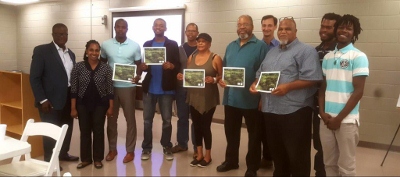Green Infrastructure Advocacy Training

In the spring of 2016, ECO-Action piloted Green Infrastructure Advocacy Training, a program for community outreach and engagement toward the development and use of parks and the application of green infrastructure (GI) to address stormwater issues in the Turner Field communities of Mechanicsville, Peoplestown and Summerhill
By training community members to be GI advocates, the pilot program increased community capacity for engagement with green infrastructure in parks as community assets that:
- address flooding and stormwater issues in the Intrenchment Creek Watershed,
- could employ residents,
- provide opportunities for recreation and education, and
- protect the natural environment.
[su_pullquote]
“If we don’t care and do not stand up for ourselves, why should we expect other people to care and standup with us?”
—Ms. Bernice Brown, Graduate of the Green Infrastructure Advocacy Training and lifelong resident of the Turner Field neighborhood of Peoplestown[/su_pullquote]
The initial project focused on the neighborhoods near Turner Field. An expanded version of the program Atlanta Watershed Learning Network evolved from this initiative. The Network partners residents of Intrenchment Creek with those of Proctor Creek to learn about their watersheds, collect samples for Citizen Science activities and advocate on behalf of watershed protection.
RESOURCE LINKS:
Here are links to some of the articles that have discussed this initiative and provided additional resources:
Resilience: It’s Not Just for Rivers “In the wake of the Braves’ exodus, the Turner Field Community Benefits Coalition (TFCBC) surveyed almost 1,000 neighborhood residents, and determined that “A well-integrated, mixed use development” tops the list of community desires. The #1 answer to the statement, “The new development should…” was “…manage stormwater.”
After discussing these results with the TFCBC, American Rivers considered how the benefits of green stormwater infrastructure could address several of the community’s top priorities beyond just managing stormwater.”
Beyond the Braves: Green Stormwater Infrastructure for Sustainable Communities Around Turner Field “After reviewing these results with residents, we at American Rivers considered how the benefits of green stormwater infrastructure (GSI) could address several of the community’s top priorities. So we offered to assist both the TFCBC and the LCI in crafting robust, yet realistic recommendations for the implementation of GSI for the redevelopment, as well as for the adjacent interstate highways—a major source of runoff.”
Building a Voice for Green Infrastructure “The next phase was focused on providing a Watershed Advocacy Training to local community members, many of which are leaders in their respective neighborhood associations or community groups. The six monthly meetings included lectures and discussion led by expert speakers on subjects ranging from infrastructure and environmental justice to advocacy and community organizing. ”
Other articles highlight ECO-Action and American River’s partnership with Climate Interactive and the Partnership for Southern Equity. Together these four organizations seek strategies to avoid gentrification as green infrastructure brings more greenspace to low-income neighborhoods:
New Challenges in Green Stormwater Infrastructure – How to Avoid Gentrification? “We hear a lot these days about the gentrification of urban low-income and communities of color. These neighborhoods often don’t have much public green space, but that’s generally the least of their worries — they often deal with more dire environmental problems as well, such as pollution from industry, flooding, etc. However, when these problems are fixed — the greenspace moves in, the industry moves out, new and improved infrastructure is built — the neighborhood suddenly becomes appealing to a new, more affluent demographic. ”
How Can Atlanta Grow Greener For All? “….But there is one thing very few cities have figured out: how does a city ensure that everyone benefits — including those who reside in diverse, low-wealth communities — as city neighborhoods become more attractive? How, for instance, does a city make room for new people without disenfranchising and displacing the people who are there today? Not only that, how do the current residents get a place at the table where decisions are being made about the growth that is happening in their communities?”
